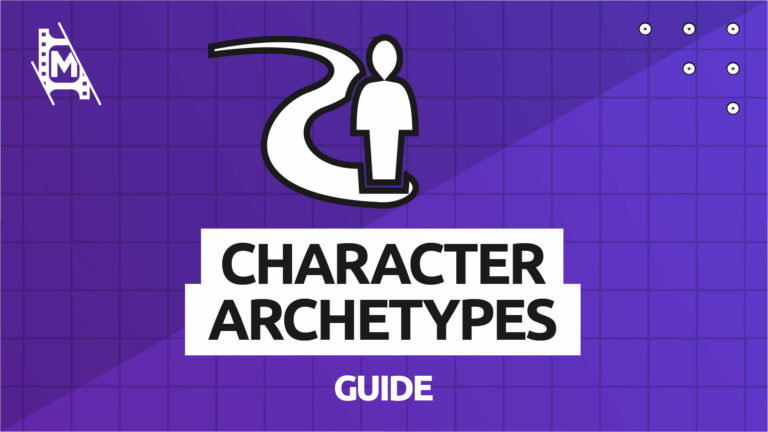Have you noticed that various films and stories have somewhat similar characters? Sometimes they even have similar features? For example, isn’t it strange that Gandalf from Lord of the Rings and Albus Dumbledore from Harry Potter are way too alike? Well, then you might have heard of the 8 archetypes.
No, it is not strange that characters from films are so similar to each other. This is because these characters represent aspects of human nature in every story. They reflect human experience and universal motifs. And you can find a lot of that in films and TV. In fact, most characters fit 8 universal archetypes.
So in this article, we will go into detail on each of these character archetypes, provide examples from films, and how you can incorporate them into your story.
What are Archetypes?
The term archetype derives from the theory of psychoanalysis developed by Swiss psychiatrist Carl Gustav Jung. In his words, the archetype is a “primitive mental image inherited from the earliest human ancestors, and supposed to be present in the collective unconscious.”
With the rise of analytical psychology in the past 50 years, many archetype-related theories developed. Different theories might suggest different numbers of archetypes present; same say there are only 4, others would argue that there are 22 different archetypes.
However, the 8 primal archetypes used the most in film & TV stories were developed by the godfather of modern storytelling theory Joseph Campbell. In The Hero with a Thousand Faces, Campbell explores eight characters in the hero’s journey.
These 8 archetypes are the:
- Hero
- Mentor
- Shadow
- Ally
- Guardian
- Shapeshifter
- Trickster
- Herald
We will explore each archetype in-depth and give examples of these characters from Star Wars and The Dark Knight. Two films that use the 8 archetypes masterfully.
The 8 Archetypes of the Hero´s Journey
1. The Hero

The Hero is essentially your protagonist. This is the character that your story will be impossible without. For your story to be complete, your hero needs to leave the ordinary world and embark on an adventure (both physical and metaphorical) that will help him or her grow and develop. This is a universal storytelling structure that is also known as a monomyth.
The hero archetype is usually a personification of goodness, justice, and kindness. As an audience, you want your hero to succeed because you truly believe in their mission and perhaps even see yourself in the character. Because aren’t we all heroes of our own lives? Don’t we constantly try to become the better versions of ourselves?
There are two keys to writing a character with a Hero archetype.
First and foremost, the hero must possess a strong, primal goal. If you want the audience to empathize with your hero, this goal needs to be universal – something that we can all refer to. For instance, a desire to survive, protect your family or win the heart of someone you love.
The second vital aspect is to give your hero an internal struggle, also known as a heroic flaw. As humans, we all possess a quality that sometimes prevents us from manifesting our goals. Giving your hero character an obstacle will make an overall journey more challenging and interesting for the audience to watch.
Is it some insecurity or fear of consequences that stop them from releasing their true potential? Or is it pride and arrogance that overinflate their ego and prevent them from action? You decide what internal obstacles will make your hero’s journey more challenging and what will help your hero grow throughout.
If you are interested in learning more about Hero’s Journey in relation to the 8 archetypes, check out our Introductory article on Hero’s Journey.
Star Wars: Luke Skywalker
Luke is the protagonist of the original trilogy and the one who receives his call for an adventure. With the help of his mentor, Obi-Wan, Luke Skywalker leaves the known world of his home planet and embarks on a journey to save the princess and eventually the entire galaxy. First, however, to become the best version of himself and accomplish his goal, he needs to become a Jedi Master.
The Dark Knight: Bruce Wayne (Batman)
By day Bruce is Gotham’s beloved playboy billionaire; by night, he leads a secret life of a vigilante known as Batman. His goal is to maintain justice in the city by fighting criminals. Batman’s journey in The Dark Knight begins when Joker (the Shadow archetype) starts causing issues and threatens the balance that Batman has brought into Gotham. Now, Bruce Wayne sets on an adventure to fight an adversary, restore the balance in his city, and learn for himself what real justice means.
2. The Mentor

The Mentor figure is one of the most important characters in the story, which essentially helps the protagonist to set out for an adventure. This archetype is also known as the Wise Old Man.
These mentor figures are the ones that contribute towards the intellectual development of the protagonist and give useful advice on how to proceed through their journey based on their own experience. Often, they have been in the same position as the hero in their past. Therefore they demonstrate a self-fulfilled version of the hero in the future.
The Star Wars: Obi-Wan Kenobi
Obi-Wan is a vivid example of a mentor archetype in the original Star Wars. He appears in Luke’s life when the hero receives his call for an adventure and initiates him into ways of the force.
Like a wise grandfather, Obi-Wan shares his ancestral knowledge of Jedi Knights and gives Luke his amulet/weapon (a symbol of initiation), the lightsaber. Throughout their journey to the Death Star, Obi-Wan gives Luke important advice on how to proceed and what decisions to make until Obi-Wan loses his life. The loss of a mentor figure becomes a vital part of Luke’s growth and his establishment as a hero.
The Dark Knight: Alfred Pennyworth
Alfred is another evocative example of the mentor figure. He is the manifestation of loyalty and wisdom that has watched Bruce Wayne growing up and supporting him on every stage of his journey to becoming Batman. Throughout the film, Alfred gives Bruce wise advice and tools to defeat Joker and restore justice that this havoc has brought.
3. The Shadow

The Shadow Archetype is also known as an antagonist. It is your villain of the story. These characters are the manifestation of a physical obstacle for your protagonist. However, sometimes these villains have noble causes and are not that evil after all. Therefore if your protagonist is a villain or an anti-hero, expect a good guy to be their shadow.
In Jungian psychoanalysis, the shadow consists of repressed ideas, emotions, and traumas. The hero can not complete the journey unless the shadow is faced, fought, and integrated.
Star Wars: Galactic Empire / Darth Vader
The shadow of the Star Wars Universe is the Galactic Empire (that represents an entire institution of malice). However, it is largely manifested through Darth Vader. He is the tyrant and a master of Dark Force. He is the main obstacle that Luke must face to defeat the Empire and restore order in the universe.
(Spoiler Alert: things get even more complicated when it turns out that Darth Vader is Luke’s father.)
The Dark Knight: Joker.
Joker is one of the greatest antagonists ever created. The Joker is so feared and loved that he is an example of an ideal shadow archetype. Joker represents an absolute chaotic madness that completely challenges the order that Batman has been establishing in Gotham. He represents the uncertainty and madness of the world that Bruce Wayne has been trying to fight and suppress for so long.
4. The Ally

The ally is the side-kick character who assists the hero on their adventure. Very often, these characters provide comic relief or develop their own secondary storyline known as a B-storyline. In addition, these characters often complement the hero with a particular quality or skill. For example, if the hero possesses a sharp intellect but does not know how to fight, the ally better possesses fighting skills.
Traditionally, there is more than one ally. Each one of the characters is incredibly different from one another, which sometimes creates internal/ally conflict, comic relief among the 8 archetypes and reinforces the power that Hero’s group possesses.
On a mythological level, of the 8 archetypes, the ally acts as proof that the purpose of the hero’s quest is universal. In other words, other forces support the mission and therefore reinforce the importance of the journey.
The Star Wars: Chewbacca, C3PO, Princess Lea & more.
An ensemble of multi galactic species, droids, and humans helps Luke on the journey. They add authenticity to the story, make the overall quest memorable and universal, and all work towards the common goal: restoration of balance in the universe.
The Dark Knight: Rachel Dawes, James Gordon, Lucius Fox & more.
Each ally in The Dark Knight is also a physical embodiment of a theme or tool. Rachel is Bruce’s love interest, which symbolizes his longing for an ordinary life, and therefore adds fuel to the internal struggle. James Gordon is an embodiment of justice in a classical sense; his failures challenge our ideas of justice and complexifies Batman’s journey. Lucius Fox is a manifestation of technological power that tends to be a tool for Batman but eventually becomes an obstacle.
5. The Guardian

The guardian often acts as another obstacle for the hero on the way to accomplish their quest and manifest their destiny. The guardian archetypes usually protect a secret, treasure, or the final MacGuffin of the story.
Traditionally, the guardian characters were mythological creatures, such as dragons, minotaurs, wizards, and other deadly beasts. In the modern storytelling theories, the guardian characters might not necessarily be the adversary (however, very often they are), but they are there to protect the hero and warn them of the dangers of the adventure. Thus, for the hero to pass by the guardian and continue the adventure, there needs to be a trick, tool, or skill that will be able to pacify them.
The Star Wars: Storm Troopers
Similar to Darth Vader, they are the extension of the evil in the galaxy. They are the army of bad guys who oppose Luke & his squad to restore peace in the galaxy. Storm Troopers usually appear as obstacles to the heroes and initiate the fight when the latter are so close to achieving a particular goal.
The Dark Knight: Criminals & Civilians
On the one hand, it is the group of Joker’s associates who prevent Batman from getting to Joker. They are obstacles that protect the desired target of Batman. On another note, Gotham’s civilians understand Batman as a symbol of vigilante justice and do not want his identity to be revealed. These two kinds of guardians further amplify Batman’s internal struggle.
6. The Shapeshifter

The Shapeshifter is a character that has a double-sided agenda and changes throughout the story together with the hero. These characters are usually the sidekicks and have questionable morals.
Shapeshifters are also known as outlaws or anti-heroes. They often betray the hero and their cause, or in contrast, appear as an unexpected source of help. They also bring suspense to the stories and constantly make the viewers question their judgments.
The Star Wars: Han Solo
Even though Han Solo is one of the main characters, as a viewer, you never really know whose side he is fighting on until the very end. At first, Han Solo is introduced to the viewers as a cynical, ego-centric, and selfish smuggler. However, as the plot unfolds itself, we truly see Han Solo’s growth and desire to be the better version of himself. Han Solo has a hero’s journey of his own.
The Dark Knight: Harvey Dent (Two-Face)
Harvey Dent is one of the most compelling and complicated characters in the film. On one side, he is the White Knight, a promising leader that Gotham needs. On another hand, after the loss of his loved one, he becomes the epitome of hatred and anger. Structurally, he shape-shifts after he becomes the burn victim. Visually, his shape-shifter quality is depicted through his Two-Face appearance (one side burnt, the other is not). His actions are dictated by a mere chance of throwing a coin, which further amplifies his shape-shifting quality.
7. The Trickster

Of the 8 archetypes, the trickster is the character that challenges the overall status quo of the story. The trickster’s main function is to test the protagonist. This archetype appears in mythologies from all around the world. This character breaks the established rules of gods, deities, and rulers, sometimes maliciously yet with ultimately positive effects. Trickster pulls pranks, uses deceits, humor, and sarcasm to eventually shed light on the truth.
The Star Wars: Master Yoda
Yoda tricks Luke Skywalker into believing that he is not a Jedi master that Luke has been looking for but a senile swamp creature. Throughout their interaction, Yoda tests Luke and makes him question the overall status quo of his journey. When Luke passes Yoda’s challenges and tricks, Yoda reveals his true self and continues educating Luke in the mastery of the force, but now as a mentor figure.
The Dark Knight: Coleman Reese / Joker
Coleman is an employee of Wayne’s enterprise and seems like an unimportant character (he only appears in the film three times). However, he has an important function in the overarching plot. He finds out the true identity of Batman and is ready to reveal it to the world. He tricks Lucius Fox and Bruce Wayne and demands millions of dollars to keep his mouth shut. On the other hand, Joker can also be considered as the Trickster.
Even though his primary function is that of a shadow to Batman, the original meaning of Joker in the card deck relates to the archetypal notion of the Fool (a.k.a. trickster). Joker is the one to constantly question Batman’s and Gotham’s morals potentially for the universal benefit of everyone. If you see Joker as both the shadow and trickster, this is an example of how characters in some stories might embody two archetypes or more.
8. The Herald

The herald archetype is a character or event that begins the hero’s journey. In other words, Herald can be the inciting incident itself or a messenger that comes to the hero to start the adventure.
The Star Wars: R2-D2
R2-D2 is the resourceful droid and also is the herald in the original Star Wars. Essentially, its main function is to deliver the message to Luke Skywalker, sent to him by Princess Lea. R2 becomes the physical manifestation of the Call to Adventure, as he delivers the hologram with the hidden message. The droid, later on, becomes the hero’s ally, joining Luke on his journey and providing a lot of useful resources.
The Dark Knight: Gotham
Gotham itself is the most likely candidate for the archetype of the Herald in The Dark Knight, even though it might not be so obvious at first. The inciting incident is essentially Joker sending the message out that enables Batman to reveal his identity; otherwise, people will start dying. The city itself starts responding in offbeat and peculiar ways.
It is the reaction of both civilians and the criminals that enable Bruce Wayne to begin this journey, involving Harvey Dent as the White Knight of Gotham and Joker’s havoc. This is a great example that proves that in many stories, the location (a.k.a the arena) can be the character of itself and sometimes possess archetypal qualities.
In Conclusion
Now that you are familiar with these 8 archetypes from the Hero´s Journey, you can apply this knowledge when you actively watch a film or work on a screenplay of your own.
Sometimes, these archetypes are hard to distinguish as some of the characters can possess two archetypes (e.g. Joker being both the Shadow and the Trickster), but usually, you will be able to spot them quite easily. Understanding what function each one of the archetypal characters plays will help you to distinguish them.
Knowing these archetypes will help you understand your story’s characters more but perhaps even understand yourself and the people that surround you. Remember, the archetypes represent recurring motifs and aspects of universal human experiences. Thus you can apply this archetypal knowledge to your own life.
